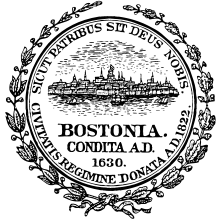Boston Police Department
The Boston Police Department (BPD), dating back to 1838, holds the primary responsibility for law enforcement and investigation within the American city of Boston, Massachusetts. It is the oldest police department in the United States.[2][3] The BPD is also the 20th largest law enforcement agency in the country and the largest in New England.[4]
| Boston Police Department | |
|---|---|
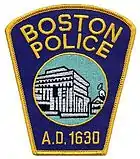 | |
 | |
 Flag of the City of Boston | |
| Abbreviation | BPD |
| Agency overview | |
| Formed | 1838 (predecessor) |
| Annual budget | $414 million (2020)[1] |
| Jurisdictional structure | |
| Operations jurisdiction | Massachusetts, U.S. |
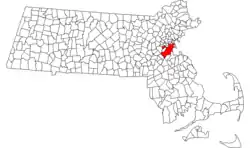 | |
| Map of Boston Police Department's jurisdiction. | |
| Size | 89.6 sq. miles |
| Population | 617,594 (2010 census) |
| Legal jurisdiction | Boston, Massachusetts |
| General nature | |
| Operational structure | |
| Headquarters | Boston, Massachusetts |
| Police Officers | 2,144 Sworn uniformed Police Officers |
| Civilian members | 569 Civilian Members |
| Police commissioner responsible |
|
| Agency executive |
|
| Facilities | |
| Patrol Vehicles | Ford Expedition, Ford F250 |
| Patrol cars | Ford Crown Victoria Police Interceptor, Ford Explorer, Chevrolet Caprice PPV |
| K-9s | 33 |
| Website | |
| bpdnews | |
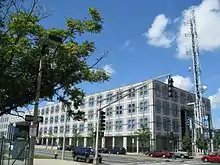

.jpg.webp)
History
Pre-incorporation (1635–1828)
Before the existence of a formal police department, the first night watch was established in Boston in 1635.[4] In 1703, pay in the sum of 35 shillings a month was set for members of the night watch. In 1796, the watch was reorganized, and the watchmen carried a badge of office, a rattle, and a six-foot pole, which was painted blue and white with a hook on one end and a bill on the other. The hook was used to grab fleeing criminals, and the rounded "bill" was used as a weapon. The rattle was a noise-making device used for calling for assistance.[5][6]
The Day Police, which had no connection to the night watch, was organized in 1838.[4] The Day Police operated under the city marshal and had six appointed officers. This organization would eventually lead to the establishment of the modern-day Boston Police Department.
Nineteenth century
In 1838, a bill passed in the General Court that allowed the city to appoint police officers, paving the way for the creation of a formal police department.[7] The Boston Police Department was formally founded in May 1854, at which point both the night watch and Day Police were disbanded. A fourteen-inch club replaced the old hook and bill, which had been in use for one hundred and fifty-four years. At the time of its founding, the Boston Police constituted one of the first paid, professional police services in the United States. The department was closely organized and modeled after Sir Robert Peel's (London) Metropolitan Police Service.[6]
On November 3, 1851, the first Irish born Boston Police officer, Bernard "Barney" McGinniskin, was appointed. His presence generated considerable controversy. The Boston Pilot wrote, "He is the first Irishman that ever carried the stick of a policeman anywhere in this country, and meetings, even Faneuil Hall meetings, have been held to protect against the appointment." At the time, the police salary of $2.00 a day for the morning and afternoon beat and $1.20 for the night watch was nearly twice as high as the wages of laborers. City Marshal Francis Tukey resisted mayor John Prescott Bigelow's appointment of McGinniskin, expressing the predominant anti-Irish sentiments in the city by arguing it was done at "the expense of an American." On January 5, 1852, shortly before the newly elected mayor Benjamin Seaver (who had been supported by Tukey) took office, Tukey fired McGinniskin without giving a reason. After criticism in the press, Seaver reinstated McGinniskin, who remained in the police until the 1854 anti-Irish groundswell of the Know Nothing/American Party movement, when in the words of the Boston Pilot, "Mr. McGinniskin was discharged from the Boston Police for no other reason than he was a Catholic and born in Ireland." McGinniskin became a United States inspector at the customhouse and died of rheumatism on March 2, 1868.[8] McGinniskin is buried in the St. Augustine Cemetery in South Boston.[6]
On October 18, 1857, at about 5:15 a.m., Boston Police Officer Ezekiel W. Hodsdon was patrolling the Corner of Havre and Maverick Street in East Boston. Hodsdon attempted to arrest two suspects for a burglary. A struggle ensued, and one of the suspects was able to get behind Hodsdon and shoot him in the head. Hodsdon died about 10:00 A.M., becoming the first Boston police officer killed in the line of duty. He was 25 years old. The murderers fled. Thousands of people visited the station house to view the body. Hodsdon left behind his wife Lydia and infant son Ezekiel who was born just 13 days prior to his death. He was buried in Woodlawn Cemetery in Everett, according to Boston Globe newspaper reports on Oct 19, 1857.[9] On October 18, 2007, a memorial was held in honor of Hodsdon on the Corner of Havre and Maverick Streets in East Boston.[6]
In 1871, the Boston Police Relief Association was founded.[6]
The Boston Police Department appointed Horatio J. Homer, its first African American officer, on December 24, 1878. He was promoted to sergeant in 1895. Sgt. Homer retired on Jan 29, 1919 after 40 years of service. He and his wife, Lydia Spriggs Homer, are buried at Evergreen Cemetery in Brighton, MA.[10] On June 26, 2010, the Boston Police Department dedicated a gravestone in honor of Sgt. Homer's service.[6]
20th century
On September 9, 1919, when Police Commissioner Edwin Upton Curtis refused to allow the creation of a police union, 1,117 BPD officers went on strike. This signaled a dramatic shift in traditional labor relations and views on the part of the police, who were unhappy with stagnant wages and poor working conditions. The city soon fell into riots and public chaos as over three-fourths of the department was no longer enforcing public peace. Governor Calvin Coolidge intervened to quash further chaos. Coolidge announced that the police did not have the right to strike against the public safety and brought in the state national guard to restore order to Boston. The strike was broken, permanently, when Coolidge hired replacement police officers, many of whom were returning servicemen from World War I, and the former officers were refused re-entry into the department. Ironically, the new officers hired in the wake of the strike received higher salaries, more vacation days and city-provided uniforms, the very demands the original strikers were requesting. The BPD strike set a precedent for further movements to stymie police unionization around the country.[6]
Coolidge's intervention in the strike brought him national fame, which, in turn, led to his nomination as Harding's running mate for Vice-President in the 1920 presidential election.
In 1921, Irene McAuliffe, daughter of the late Weston police chief and horse breeder Patrick McAuliffe, was among the first six female members of the Boston Police Department. An accomplished horsewoman, she was sworn in as a mounted officer of the Weston Police Department in 1913 during the town's bicentennial celebration. She joined the District of Columbia Police Department in 1920, and in 1921 she became a member of the Boston Police Department's Vice Squad.[6][11]
Busing crisis
In 1974 and 1975, the BPD was involved in maintaining order during the public disturbance over court-ordered busing, which was intended to racially desegregate Boston's public school system.[4][12] The protest of white citizens escalated into street battles in 1974, and in 1975 uniformed BPD officers were stationed inside South Boston High School, Charlestown High School and other Boston public schools.[12]
1982 Boston arson spree
Between 1982 and 1984 an arson ring that included BPD officers and allies set fire to 264 buildings. The ring opposed Proposition 2 1/2 which reduced the funds Massachusetts municipalities could raise through property taxes and led to cuts in fire departments and police agencies. Through committing arson, the ring hoped to cause social disorder to make the case for the necessity of firefighters and police. [13]
Charles Stuart murder investigation
In 1989 Charles Stuart killed his wife and accused an unknown Black man for the murder. BPD proceeded to conduct a manhunt targeting young Black men, indiscriminately using stop and frisk tactics, especially in neighborhoods of Mission Hill and Roxbury. Some residents compared the response to living in a war zone and the response said to have contributed to distrust between Black communities and BPD for decades following.[14]
On August 23, 1995, the BPD became the first police agency to send fingerprint images to the FBI electronically using the newly created EFIPS (now IAFIS) system. The first set of fingerprints were for a suspect arrested for armed robbery. Within hours of the receipt of the fingerprints, the FBI determined that the suspect had a number of prior arrests, including one for assault with intent to kill.[15]
21st century
On December 31, 2006, 31 Boston Municipal Police Officers were allowed to transfer to the Boston Police. On January 1, 2007, the rest of the Munis were either laid off or transferred to the city's Municipal Protective Services, which provides security to the city's Property Management Department. There was no merger with the Boston Municipal Police.
The transfers of Muni's was planned in mid-2006 by Mayor Thomas M. Menino. This plan was met with heavy protest from the Boston Police Patrolmen's Association. The BPPA's argument was that the Municipal officers were not qualified to be Boston police officers due to lack of training, political patronage, nepotism and the fact that the Munis were not civil service tested.[16]
2007 Boston Bomb Scare
On January 31, 2007, 911 callers mistakenly identified small electronic promotions found throughout Boston and the surrounding cities of Cambridge and Somerville as possible explosives. Upon investigation by Boston Police and other agencies [17] the suspicious devices turned out to be battery-powered LED placards with an image of a cartoon character called a "mooninite" used in a guerrilla marketing campaign for Aqua Teen Hunger Force Colon Movie Film For Theaters, a film based on the animated television series Aqua Teen Hunger Force on Cartoon Network's late-night programming block Adult Swim.[17]
The BPD's handling of this incident has been criticized by some Boston residents and justified by others: One resident said that the police response was "silly and insane," and that "We’re the laughing stock."[18] Another resident said that the device "looked like a bomb. I picked it up, pulled the tape off it, and there were batteries, two on the top and three on the bottom."[17] The same devices had been distributed in nine other cities across the USA without provoking a similar reaction.[18] The United States Department of Homeland Security praised Boston authorities "for sharing their knowledge quickly with Washington officials and the public."[19]
"Occupy Boston" Movement
Beginning in September–October 2011, protesters assembled in Dewey Square as a show of solidarity with the Occupy Wall Street protest in New York. The Boston Police Department handled the presence of these protesters. In the early hours of October 11, 2011, Boston Police and Transit Police moved into the protesters' secondary camp, arresting approximately 100 protesters.[20] Protesters claimed there were incidents of excessive force by police, however, Mayor Menino denied the claim, explaining that the occupation's move into another section of the Greenway endangered public safety.[21]
2020 Protests
During the 2020 protests against police brutality, the department has come under scrutiny by elected officials for its usage of tear gas against protesters.[22] Demonstrations against police brutality began in the city in May 2020 and continued through June.[23]
Alleged overtime fraud
In early September 2020, United States Attorney Andrew Lelling indicted nine former and current Boston police officers for allegedly collecting more than $200,000 in fraudulent overtime payments while working in the department’s evidence warehouse.[24]
Departmental organization
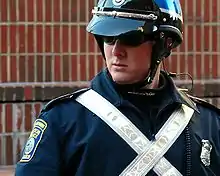
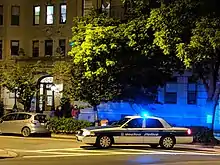

The Boston Police Department has approximately 2,015 officers and 808 civilian personnel, with patrol services covering an area of 89.6 mi2 (232.1 km2) and a population of 617,594. Like all City of Boston departments, the BPD requires all employed officers hired since 1995 to live within Boston city-limits. The BPD is divided into three zones and 11 neighborhood districts spread across the city, with each zone supervised by a Deputy Superintendent and every district headed by a Captain.[6]
The Boston Police Department is organized into bureaus under the Office of the Police Commissioner. The Chief of Staff, media liaisons and the Boston Regional Intelligence Center (BRIC) also operate out of the Commissioner's office.[25]
The Bureau of Field Services (BFS) consists of the zone commands and police districts, the Special Operations Unit and Youth Violence Strike Force (gang unit). It is the largest bureau and its main responsibility is tactical patrol and crime prevention.
The Bureau of Investigative Services (BIS) consists of the Homicide Unit, Drug Control Unit, Family Justice Center and Forensic Science Division. Superintendent Kevin Buckley is the head of the BIS.
Other bureaus include the Bureau of Administration & Technology and the Bureau of Professional Standards and Development, which encompasses the Training and Education Division, Internal Affairs and Anti-Corruption, headed by Superintendent Frank Mancini.
Ranks
The Boston Police rank structure is as follows:
| Title | Insignia | Notes |
|---|---|---|
| Commissioner (civilian) | Appointed by the Mayor of Boston. Is the executive head of the department. | |
| Superintendent In Chief |  |
Highest-ranking police officer in the department. This position is not always filled. |
| Superintendent | Superintendents are typically in charge of a Bureau, or they can be the director of the academy | |
| Deputy Superintendent | Deputy Superintendents are typically second-in-command of a Bureau, or the deputy director of the academy | |
| Captain/Captain Detective | Captains are typically commanders in charge of a district, or unit commander in academy, or service chief in the department administration | |
| Lieutenant/Lieutenant Detective | Lieutenants are holding the functions of second-in-command the district, or Unit leader in district, or service chief in the department administration, or instructor in academy | |
| Sergeant/Sergeant Detective | Sergeants are holding a functions of district sergeant, or unit deputy chief in district or staff sergeant in the department administration, or instructor in academy | |
| Detective | Detective is a rank, guaranteed by a Legislative Act of 1986, they work in civil clothes and hold the function of an investigator. | |
| Police Officer | Police Officers are the first ranking officers. | |
| * Certain jobs within the department are designated as Detective Supervisor jobs (District Det. Supervisor, Sexual Assault Unit, Domestic Violence, etc.), then, Detective Supervisors earn their "rating" after serving a certain amount of time in said role. | * Deputy Superintendents and above serve at the pleasure of the Police Commissioner and in the case of the Commissioner, the Mayor. | |
Leadership

Dennis White has been the commissioner since February 1, 2021;[26] he was placed on leave on February 3, 2021.[27] Gregory P. Long has been the superintendent-in-chief since August 2018;[28] he was named acting commissioner upon White being placed on leave.[27]
Kathleen O'Toole was the first woman to serve as commissioner, from February 2004 through May 2006 when she left to take a new position as Chief Inspector of the Inspectorate of the Irish national police force, the Garda Síochána.[29]
Members of the Boston Police Commission
A three-person police commission (also called the police board) consisted of members nominated by the Governor of Massachusetts and approved by the Massachusetts Governor's Council. The commission was established in 1878 and abolished in 1906.
| Name | Term start | Term end |
|---|---|---|
| Henry S. Russell | July 8, 1878 | March 1, 1880 |
| Samual R. Spinney | July 8, 1878 | May 3, 1880 |
| James M. Bugbee | July 8, 1878 | May 5, 1879 |
| Henry Walker | May 5, 1879 | April 21, 1882 |
| Edward J. Jones | March 26, 1880 | April 21, 1882 |
| Thomas J. Gargan | May 3, 1880 | April 21, 1882 |
| Thomas L. Jerks | April 22, 1882 | July 23, 1885 |
| Nathaniel Wales | April 22, 1882 | July 7, 1885 |
| Benjamin D. Barley | April 22, 1882 | May 6, 1883 |
| Michael P. Curran | May 7, 1883 | July 23, 1885 |
| Albert T. Whiting | July 2, 1885 | May 6, 1895 |
| William H. Lee | July 23, 1885 | May 28, 1894 |
| William M. Osborne | July 23, 1885 | April 30, 1893 |
| Robert F. Clark | May 1, 1893 | May 4, 1903 |
| Augustus P. Martin | May 28, 1894 | May 1, 1899 |
| Charles P. Curtis Jr. | May 6, 1895 | May 1, 1905 |
| Harry F. Adams | May 1, 1899 | June 4, 1906[30] |
| William H. Emmons | May 5, 1903[31] | June 4, 1906[30] |
| Charles H. Cole | May 1, 1905[32] | June 4, 1906[30] |
List of Boston Police Commissioners
Boston's police commissioner was appointed by the Governor until 1962.[33] Edmund L. McNamara was the first commissioner to be appointed by the Mayor of Boston, taking office in April 1962 via appointment by mayor John F. Collins.[34] Once appointed, a commissioner can only be removed from the position for cause until their term expires.[35] A commissioner may be appointed to a five-year term, or to serve the remainder of a predecessor's five-year term.[35]
Names in italics indicate a person served as acting (interim) commissioner only. Since 1985, several acting commissioners have been sworn as permanent. Numbering is per cited contemporary news reports and may include inconsistencies.
| No. | Name | Acting | Sworn / permanent | Ref. | ||
|---|---|---|---|---|---|---|
| Term start | Term end | Term start | Term end | |||
| Stephen O'Meara | June 4, 1906 | December 14, 1918 | ||||
| Michael H. Crowley | December 14, 1918 | December 30, 1918 | ||||
| Edwin Upton Curtis | December 30, 1918 | March 28, 1922 | ||||
| Michael H. Crowley | March 28, 1922 | April 3, 1922 | ||||
| Herbert A. Wilson | April 3, 1922 | May 5, 1930 | ||||
| Michael H. Crowley | May 5, 1930 | May 8, 1930 | ||||
| Eugene Hultman | May 8, 1930 | December 27, 1934 | ||||
| Joseph J. Leonard | December 27, 1934 | February 23, 1935 | ||||
| Eugene M. McSweeney | February 23, 1935 | November 25, 1936 | ||||
| Joseph F. Timilty | November 25, 1936 | March 27, 1943 | ||||
| Thomas S. J. Kavanagh | March 27, 1943 | June 5, 1943 | ||||
| Joseph F. Timilty | June 5, 1943 | November 25, 1943 | ||||
| Thomas F. Sullivan | November 26, 1943 | August 27, 1957 | ||||
| James F. Daley | August 27, 1957 | September 4, 1957 | ||||
| Leo J. Sullivan | September 4, 1957 | March 15, 1962 | ||||
| Francis J. Hennessy | March 15, 1962 | April 6, 1962 | ||||
| Edmund L. McNamara | April 6, 1962 | May 31, 1972 | ||||
| William J. Taylor | May 31, 1972 | November 1, 1972 | ||||
| Robert diGrazia | November 1, 1972 | November 15, 1976 | ||||
| Joseph M. Jordan | November 15, 1976 | January 31, 1985 | ||||
| Francis Roache | February 1, 1985 | March 13, 1985 | March 13, 1985 | June 30, 1993 | ||
| William J. Bratton | June 30, 1993 | January 10, 1994 | ||||
| 35 | Paul F. Evans | January 10, 1994 | February 14, 1994 | February 14, 1994 | November 14, 2003 | [36] |
| James Hussey | November 14, 2003 | February 19, 2004 | ||||
| 37 | Kathleen O'Toole | February 19, 2004 | May 31, 2006 | [37] | ||
| Al Goslin | May 31, 2006 | December 5, 2006 | ||||
| Edward F. Davis III | December 5, 2006 | November 1, 2013 | [38] | |||
| 41 | William B. Evans | November 1, 2013 | January 9, 2014 | January 9, 2014 | August 4, 2018 | [39] |
| 42 | William G. Gross | August 4, 2018 | August 6, 2018 | August 6, 2018 | January 29, 2021 | [40] |
| 43 | Dennis White | January 29, 2021 | February 1, 2021 | February 1, 2021 | February 3, 2021 (on leave) | [41][27] |
| Gregory Long | February 3, 2021 | present | [27] | |||
Districts
The following is a list of districts that the BPD serves:[42]
District A-1, District A-15
- Serves: Downtown, Beacon Hill, Charlestown (investigations and community service), Chinatown, North End, West End, Leather District, Bay Village, and the Downtown Waterfront.
- Population Served: 55,971
- Station Address: 40 Sudbury St., Boston, MA 02114
- Commanded by: Captain Kenneth Fong
District A-7
- Serves: East Boston
- Population Served: 40,508
- Station Address: 69 Paris St., East Boston, MA 02128
- Commanded by: Captain Kelly J. McCormick
District B-2
- Serves: Roxbury/Mission Hill
- Population Served: 76,917
- Station Address: 2400 Washington St., Roxbury, MA 02119
- Commanded by: Captain Leighton Facey
District B-3
- Serves: Mattapan/North Dorchester
- Population Served: 36,480
- Station Address: 1165 Blue Hill Ave., Dorchester, MA 02124
- Commanded by: Captain Haseeb Hosein
District C-6
- Serves: South Boston
- Population Served: 35,200
- Station Address: 101 W. Broadway, South Boston, MA 02127
- Commanded by: Captain Joseph Boyle
District C-11
- Serves: Dorchester
- Population Served: 91,982
- Station Address: 40 Gibson St., Dorchester, MA 02122
- Commanded by: Captain Steven McLaughlin
District D-4
District D-14
District E-5
- Serves: West Roxbury/Roslindale
- Population Served: 50,983
- Station Address: 1708 Centre St., Boston, MA 02132
- Commanded by: Captain Therese Kozmiski
District E-13
- Serves: Jamaica Plain
- Population Served: 37,468
- Station Address: 3345 Washington St., Jamaica Plain, MA 02130
- Commanded by: Acting Captain John Greland
District E-18
- Serves: Hyde Park
- Population Served: 30,631
- Station Address: 1249 Hyde Park Ave., Hyde Park, MA 02136
- Commanded by: Captain Joseph Gillespie
Divisions

The following is a list of the divisions of the BPD: [43]
- Forensic Technology Division: Provides forensic services within the Boston Police Department through the following Units:
- The Crime Laboratory Unit is part of the Forensic Technology Division. The Crime Lab provides services to the City of Boston, MBTA, and several of the colleges and universities in Boston. This unit provides many services including: crime scene processing and evidence preservation, evidence collection, evidence & case review, analysis of evidence and reporting of results, courtroom testimony, in-service training, and various forensic lectures & presentations.
- The Firearm Analysis Unit is part of the Forensic Technology Division. This Unit provides forensic support to the Boston Police Department, Federal Law Enforcement Agencies and area college and university police departments. This unit provides many services including: firearm and ammunition certification, comparison of ballistic evidence, crime scene processing and evidence preservation, evidence collection, evidence & case review, analysis of evidence and reporting.
- The Latent Print Unit provides forensic support to the Boston Police Department, Federal Law Enforcement Agencies and area college and university police departments. This unit provides many services including: recovery and analysis of latent fingerprints, crime scene processing and evidence preservation, evidence collection, evidence & case review, analysis of evidence and reporting of results, courtroom testimony, in-service training, and various forensic lectures & presentations.results, courtroom testimony, in-service training, and various forensic lectures & presentations.
- The Family Justice Division consists of the following units within the Boston Police Department:
- Crimes Against Children Unit
- Domestic Violence Unit
- Human Trafficking Unit
- Sexual Assault Unit
- Media Relations is a part of the Office of the Police Commissioner. Media Relations provides public information to local and national media outlets, conducts news conferences and interviews, and provides Department spokespersons to ensure that the public receives timely and accurate information about department-related activities, programs, services and personnel.
- Internal Affairs investigates incidents of alleged police misconduct; reviews complaint investigations to ensure that investigations are thorough and complete; analyzes all complaint data; and proactively assists in the development of needed training modules.
- The Boston Police Harbor Unit, led by the harbormaster, patrols the harbor daily to ensure that both commercial and recreational use of the harbor and its islands is safe. The unit also enforces maritime codes and environmental regulations as they apply to these waters.
- The Boston Police Rescue/Recovery Dive Team has 22 members and is overseen by a sergeant. The team is made up of various members of the department working all across the city that may be activated, as needed. The team responds to all underwater incidents in the city or in the 42 square miles of Boston Harbor. Also, the team is the primary investigative unit for any crimes that may occur on the Harbor Islands.
- The Boston Police Licensing Division oversees civilian firearms licensing, Rule 400 Special Police Officer Licensing, and the Hackney Carriage Unit, which is responsible for regulating all taxis, sightseeing automobiles, horse and carriages, and pedicabs in the city of Boston.[44]
- Boston Police Special Operations Unit is a specialized unit within the Boston Police Department responsible for combined duties involving highway patrol and traffic enforcement, crowd control, and special weapons and tactics (SWAT) services within the city. One unique feature of the unit is that the Special Operations Unit primarily relies on the use of Ford Crown Victoria Police Interceptors and Harley-Davidsons in their daily patrols. The use of motorcycles allows the unit to perform routine traffic enforcement; accompany parades, crowds, and visiting dignitaries; and to quickly travel to situations wherein the unit's SWAT skills are requested. Specialized trucks and support vehicles are also used to transport equipment and officers when needed. The Canine Unit, Bomb Squad, Hazardous Materials Response Unit and the Truck Team are also under the Special Operations Division.
- The high-tech desk provides inter-divisional technical support in areas such as IT (Information Technology), Digital Forensics support, and assists in investigations of cybercrime.
- Boston Police Gaelic Column of Pipes & Drums. Founded in 1992, The Boston Police Gaelic Column is an independent, non-profit organization consisting of Boston Police officers and law enforcement officers from the greater Boston area. The Gaelic Column is affiliated with the Boston Police Department but is funded entirely through the efforts of its members and supporters. They perform at Boston Police events, parades and other events throughout the Boston area.[45]
The Boston Police Department ran a cadet program, where 18- to 24-year-olds were assigned to a division where they performed administrative tasks such as writing reports and directing traffic. After two years as cadets, they were eligible to be candidates at the Police Academy. This program was cut in 2009, due to budget cuts and was brought back in 2015. New Police cadets first started on November 14, 2016.
Equipment
Transportation
The Boston Police uses the following vehicles.
- Ford Police Interceptor SUV – Current issue patrol car.
- Chevy Caprice Current issue patrol car.
- Chevy Impala Current issue patrol car.
- Chevy Tahoe PPV – Current issue patrol car.
- Ford Crown Victoria Police Interceptor – Mostly phased out as of July 2019. Occasionally seen on a detail, etc.
- Ford F-250 - Prisoner Transport Vehicle (paddy wagon)
- Ford Expedition
- Harley-Davidson
- HMMWV
Weapons
Boston police officers may carry "only weapons, magazines and ammunition authorized and issued by the Department", which "include, but are not limited to":[46]
- Benelli M3 SBS (12 gauge)
- Bushmaster XM-15 (.223 Remington)
- Glock Model 22[46] (.40 S&W)
- Glock Model 23[46] (.40 S&W)
- Glock Model 27[46] (.40 S&W)
- SIG Sauer GSR in .45 ACP[47][48]
Community policing
In the 1990s the police department resurrected an old idea, the Walk & Talk strategy. Police officers assigned to patrol cars are required to walk a particular area for up to 45 minutes or longer per their tour of duty. The establishment of other initiatives like "Same Cop Same Neighborhood" and "Safe Street Beat Teams" have contributed widely to the continued success of community policing. These types of direct patrol were more widely expanded under the leadership of Police Commissioner Davis. Under his command Patrol Supervisors and police officers who were normally assigned to administrative duties were encouraged to perform a foot patrol. This type of patrol assignment is referred to as a Code 19.
Demographics
- By gender
- Male: 84%
- Female: 16%[49]
- By race
- White: 65.5%
- African-American/Black: 23.9%
- Hispanic: 8.3%
- Asian: 2.4%[50]
Fictional portrayals
The Boston Police Department has been portrayed in several prominent motion pictures including Patriots Day, Gone Baby Gone, Mystic River, The Departed, Edge of Darkness, Blown Away, The Brinks Job, That's My Boy, R.I.P.D., The Heat, the second "X-Men" film X2 (film), What's The Worst That Could Happen?, The Boondock Saints, Surrogates, and The Town. BPD is also featured in the television series Spenser: For Hire, Rizzoli & Isles, Leverage, Crossing Jordan, Fringe, and the failed Katee Sackhoff/Goran Visnjic police show pilot Boston's Finest.
Fictional BPD districts
Due to filming on location in the Boston area, fake BPD cruisers have been marked with fictional districts to avoid confusion with real BPD cruisers. They include:
- District A-4
- District A-8
- Featured in
- That's My Boy outside a housing project
- The Town throughout the film
- R.I.P.D. during the raid where Nick is killed
- Ted 2 seen on the side of a police car
- Patriots Day outside of David Henneberry's house on April 19
- District D-6
- Featured in
- The Town outside Fenway Park during the final gunfight scene
- District G-4
- Featured in
- District G-5
- Featured in
- Edge of Darkness outside Craven's house as part of a protection detail
- The Heat Mullins works out of it, but it is somehow part of Area F rather than Area G
- District G-8
- 19th Precinct
- Featured in
- What's the Worst That Could Happen? Detective Tardio claims to be from it when first introducing himself
See also
References
- "Fiscal Year 2020 Adopted Budget" (PDF). City of Boston. 2020. Retrieved 2020-06-04.
- http://time.com/4779112/police-history-origins/
- http://plsonline.eku.edu/insidelook/history-policing-united-states-part-1
- A Brief History of The B.P.D. Archived 2012-03-04 at the Wayback Machine City of Boston, Police Department (accessed 3 December 2009)
- Taylor, J. "The Victorian Police Rattle Mystery" Archived 2010-02-18 at the Wayback Machine The Constabulary (2003)
- BPD Chronologist
- "A Brief History of the B.P.D." City of Boston.gov. City of Boston. 2011. Archived from the original on March 4, 2012. Retrieved February 26, 2012.
- Peter F. Stevens: The Hidden History of the Boston Irish p.42-45
- The Officer Down Memorial Page
- Information Taken from Boston Police Commissioner Order on January 29, 1919 online at the BPL.
- Boston Police Archives & Commissioner Orders
- Boston: Preparing for the Worst Time. September 15, 1975.
- Sweeney, Emily (September 9, 2019). "New book 'Burn Boston Burn' looks at arson ring that set more than 200 fires in the 1980s". Boston Globe.
- Bernard, Diane (2020-01-04). "'They were treated like animals': The murder and hoax that made Boston's black community a target 30 years ago". The Washington Post. Retrieved 2020-07-11.
- 1995 Annual Report of the Attorney General of the United States: Chapter II - Supporting Law Enforcement in the Community
- According to Pat Rose.37 Boston Municipal Officers don't qualify for merger Archived September 28, 2007, at the Wayback Machine
- Smalley, Suzanne; Mishra, Raja (2007-02-01). "Froth, fear, and fury". The Boston Globe. Retrieved 2007-02-02.
- Young Bostonians think city overreacted NBC News
- "Arrest Made After 'Suspicious Packages' Paralyzed Boston as Part of Cartoon Network Marketing Campaign". Fox News. January 31, 2007.
- Ryan, Andrew; et al. (11 October 2011). "More than 100 arrested in Occupy Boston protests". Boston Globe. Archived from the original on October 11, 2011. Retrieved 11 October 2011.
- "Menino Disputes Police Brutality Claims In 'Occupy Boston' Arrests « CBS Boston". Boston.cbslocal.com. 2011-10-11. Retrieved 2012-02-17.
- "An Effort to Curtail the Use of Tear Gas on Protesters Is Underway in Massachusetts". Boston Magazine. 2020-06-03. Retrieved 2020-06-08.
- McDonald, Danny. "Throughout Mass., rallies continue to protest police brutality, systemic racism - The Boston Globe". BostonGlobe.com. Retrieved 2020-06-08.
- Ellement, John R. (2020-09-02). "Nine former and current Boston police officers charged with overtime fraud, US Attorney Lelling says". The Boston Globe. Retrieved 2020-09-02.
- Boston Police Web page
- Gavin, Christopher (February 1, 2021). "Dennis White vows to see through reforms as Boston's police commissioner". Boston.com. Retrieved February 1, 2021.
- Ryan, Andrew; Arnett, Dugan (February 3, 2021). "Walsh places new police commissioner on leave after past domestic violence allegation surfaces". The Boston Globe. Retrieved February 3, 2021.
- Valencia, Milton J. (August 10, 2018). "Gregory Long named as chief superintendent of Boston police". Boston.com. Retrieved February 1, 2021.
- Slack, Donovan (May 9, 2006). "O'Toole stepping down as Boston police commissioner". Boston.com. Retrieved February 1, 2021.
- "Retiring Police Board to be Honored". The Boston Globe. June 3, 1906. p. 25. Retrieved February 2, 2021 – via newspapers.com.
- "Judge Emmons Assumes His New Duties". The Boston Globe. May 5, 1903. p. 14. Retrieved February 2, 2021 – via newspapers.com.
- "Col Charles H. Cole Jr Begins Work as Chairman of Police Commission". The Boston Globe. May 1, 1905. p. 1. Retrieved February 2, 2021 – via newspapers.com.
- Crocket, Douglas S. (April 1, 1962). "So the Legislature Took Control, And Politics Has Ruled Since". The Boston Globe. p. 36. Retrieved February 2, 2021 – via newspapers.com.
- Davis, William A. (December 31, 1967). "McNamara: 5 Years of Controversy". The Boston Globe. p. 7. Retrieved February 2, 2021 – via newspapers.com.
- Rezendes, Michael (August 13, 1991). "State law restricts mayor on firing of city's police chief". The Boston Globe. p. 16. Retrieved February 4, 2021 – via newspapers.com.
- Cullen, Kevin (February 15, 1994). "From Southie, via Nam, a police leader emerges". The Boston Globe. p. 1. Retrieved February 1, 2021 – via newspapers.com.
- Klein, Rick (February 9, 2004). "1st female commissioner faces labor, convention challenges". The Boston Globe. p. 1. Retrieved February 1, 2021 – via newspapers.com.
- Cramer, Maria (November 1, 2013). "A selective, assured Davis ready for next stage". The Boston Globe. p. B1. Retrieved February 2, 2021 – via newspapers.com.
- Cramer, Maria (January 18, 2014). "As he takes office, Evans vows to put more officers on street". The Boston Globe. p. B1. Retrieved February 1, 2021 – via newspapers.com.
- Valencia, Milton J. (2018-08-05). "William Gross, set to be sworn in as Boston's first black police commissioner, was an officer in the making, friends say". The Boston Globe. Retrieved 2018-08-06.
- Gavin, Christopher (February 1, 2021). "Dennis White vows to see through reforms as Boston's police commissioner". Boston.com. Retrieved February 1, 2021.
- Boston Police Department Website, Retrieved on 2010.05.18
- "Divisions | City of Boston". Cityofboston.gov. 2012-02-13. Retrieved 2012-02-17.
- "Hackney Carriage Unit | Boston Police | City of Boston". Cityofboston.gov. Retrieved 2012-02-17.
- "Boston Police Gaelic Column of Pipes and Drums". Retrieved February 23, 2012.
- "Boston Police Department Rules and Procedures: Rule 303, Use of Deadly Force" (PDF). Boston Police Department. 11 April 2003. Section 9, page 5. Archived from the original (PDF) on May 26, 2012. Retrieved 2 December 2011.
- "Police Weapons in the USA: Massachusetts". Boston Police Department. 11 April 2003. Retrieved 2 December 2011.
Sigarms .45 Caliber Pistol – 8 Rounds
- "Pistol Specifications" (PDF). SIG Sauer. Chart 1. Archived from the original (PDF) on 27 October 2011. Retrieved 2 December 2011.
- Law Enforcement Management and Administrative Statistics, 2000: Data for Individual State and Local Agencies with 100 or More Officers Archived August 2, 2009, at the Wayback Machine
- Police Department Race and Ethnicity Demographic Data
- Photo of fake BPD cruiser on Fringe set
- "Photo of fake BPD cruiser on Patriots Day set". Archived from the original on 2016-06-17. Retrieved 2016-06-17.
- Photo of fake BPD cruisers with Oregon license plates
Further reading
- Francis Russell. A City in Terror: Calvin Coolidge and the 1919 Boston Police Strike (Boston: Beacon Press, 1975, ISBN 978-0-8070-5033-0).
External links
- Official website
- 2006 Boston Globe article on the Municipal Police Department/Boston Police Department merger
- The Police News Collection, Scrapbooks, 1961-1968 are located in the Northeastern University Libraries, Archives and Special Collections Department, Boston, MA.
- The Elmer V.H. Brooks papers, 1924-1998 (Bulk 1937-1968) are located in the Northeastern University Libraries, Archives and Special Collections Department, Boston, MA.
- The Justice George Lewis Ruffin Society records, n.d., 1848-1853, 1885-1893, 1963-2005 (bulk 1984-2005) are located in the Northeastern University Libraries, Archives and Special Collections Department, Boston, MA.
- Boston Police Department Annual Reports since 1885 https://web.archive.org/web/20100613003654/http://bpl.org/online/govdocs/bpd_reports.htm
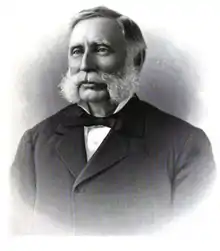


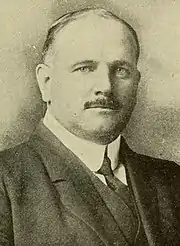
.jpg.webp)

